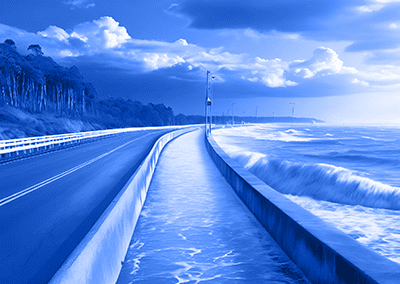
Risk-based Approach for Future Sea-Level Rise & Design Flood Elevations
A non-stationary, risk-based approach for determining design flood elevations under sea level rise
The American Society of Civil Engineers‘ article “What Role Does Sea Level Rise Have in Facility Design Elevations?” discusses the impact of sea level rise (SLR) on facility design elevations. With the threat of rising sea levels due to climate change increasing, civil engineers must consider SLR when designing infrastructure. The article highlights the importance of considering projections for future sea level rise when designing buildings, bridges, and other structures. By incorporating higher elevation requirements into design standards, engineers can ensure that infrastructure remains resilient in changing environmental conditions.
The article also emphasizes the need for collaboration between engineers, planners, and policymakers to develop strategies that address the challenges posed by sea level rise. By working together, stakeholders can create innovative solutions that mitigate risks and ensure the long-term sustainability of infrastructure. In summary, the article underscores the critical role of sea level rise in facility design elevations and calls for proactive measures to address this growing threat. Civil engineers must prioritize resilience and sustainability in design practices to protect infrastructure from the impacts of climate change.
D.J. Rasmussen, Ph.D., Aff.M.ASCE, is an applied climate scientist in the Earth & Environment hub in the San Diego office of WSP USA.
This article is published by Civil Engineering Online. It is based on a conference paper, “A non-stationary, risk-based approach for determining design flood elevations under sea level rise,” presented at the 2023 ASCE INSPIRE Conference.
The content provided in this article is for general informational purposes only.
© 2024 American Society of Civil Engineers.
(Source: D.J. Rasmussen, Ph.D., Aff.M.ASCE. “What Role Does Sea-Level Rise Have in Facility Design Elevations?” Civil Engineering Source, ASCE American Society of Civil Engineers, www.asce.org/publications-and-news/civil-engineering-source/civil-engineering-magazine/article/2024/03/what-role-does-sea-level-rise-have-in-facility-design-elevations. Accessed 15 Mar. 2024.)
ClimaTwin® is a leading climate risk intelligence solution for infrastructure assets and the built environment.
We empower infrastructure stakeholders to mitigate climate risks and assess adaptation actions across the total asset lifecycle. By connecting complex climate models and infrastructure digital twins, our solution enables owner-operators, investors, governments, engineers, and other decision-makers to aggregate, visualize, and analyze disparate datasets, revealing site-specific insights at a hyper-local scale. Benefits include 5-10x near-term returns and lifetime cost-avoidance by mitigating risks to systems, services, and societies.
To learn more about climate risk intelligence for your infrastructure assets, please visit www.climatwin.com today.
© 2024 ClimaTwin Corp. ClimaTwin® is a registered trademark of ClimaTwin Corp. ClimaTwin Basic™, ClimaTwin Enterprise™, the ClimaTwin logo, and Climate Risk Intelligence for Infrastructure Digital Twins™ are trademarks of ClimaTwin Corp. All rights reserved.
###
List of terms
- climate change
- climate

